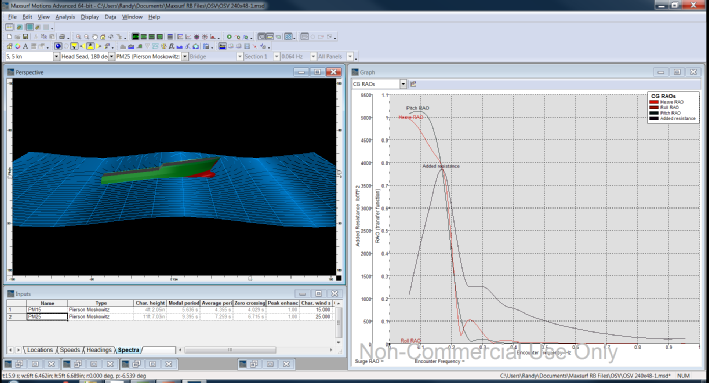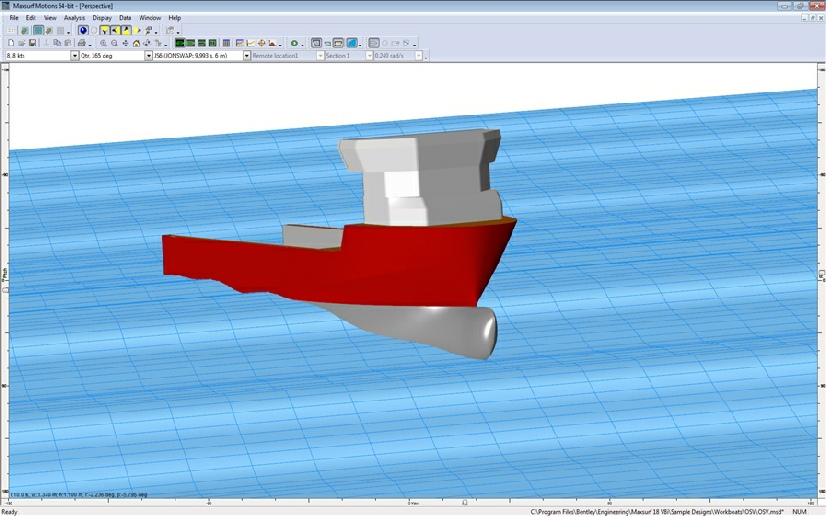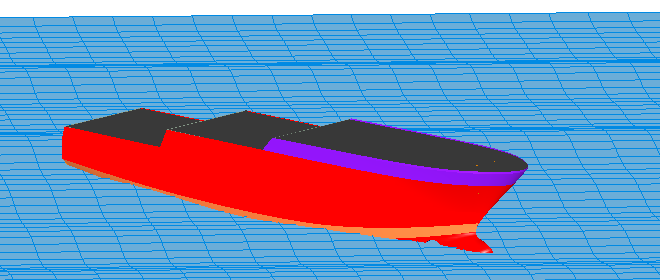Motions Seakeeping Performance Prediction
The Maxsurf Motions hydrodynamic and seakeeping analysis module provides fast, reliable calculation of vessel response and seakeeping characteristics for many types of Maxsurf designs in a variety of sea states. Please click here to contact us for more details.

The Motions program provides designers with the tools necessary to quickly predict the seakeeping performance of Maxsurf designs. Motions takes advantage of the power of modern desktop computers to bring seakeeping prediction and analysis tools within the reach of all naval architects and designers. It is now possible, in a few seconds, to read in a Maxsurf design and calculate the vessel’s seakeeping characteristics.
The hull geometry required for the analysis is read directly from the trimmed Maxsurf NURB surface model. This eliminates the need to prepare batch or offsets files. In addition, all functions within Motions are performed using a graphical multi-
All data is displayed simultaneously in graphical and tabular form and is automatically updated when changes are made and as the analysis progresses. All data may be copied to spreadsheets and other applications for presentation purposes or further analysis, e.g. calculation of probability of slamming, propeller emergence, etc.
Once the Maxsurf design file has been loaded into Motions, the user specifies the wave spectrum and heading, vessel speed and several other analysis parameters. Response amplitude operators (RAOs) are computed as well as the added resistance, significant absolute and relative motions, velocities and accelerations of the vessel in the specified sea spectrum.
Motion, velocity and acceleration and Motion Sickness Incidence (MSI) may also be computed for any position on the vessel.
|

Conformal mapping techniques are used to calculate the section added mass and damping for the vessel. Strip Theory is then used to calculate the global vessel added mass, damping and cross-
Motions is based on a Strip Theory analysis code originally developed by the Australian Maritime Engineering Co-
Motions has been used extensively for both commercial and research applications. The software has been validated against a variety of data from various independent sources: including model tests, full scale trials and other numerical methods. Typical comparisons with results from towing tank experiments are shown above. These show heave and pitch RAOs for a slender, round bilge monohull in head-
A number of alternative designs can easily be assessed and compared for seakeeping performance. Motions is able to compute the heave and pitch response over a complete frequency range in a matter of seconds on a desktop computer. Comparisons of different vessels can be made by examining the RAOs or by computing the significant motions and accelerations for a specified sea spectrum. All data generated can be graphed in Motions or exported for further analysis.
Analysis and simulation of ship response to waves in Motions
20m rescue boat at 18kn in bow-quartering waves of 6m characteristic wave height; unidirectional wave spectrum…
Animation


MAXSURF Motion Intro video
For 2025 the calm water resistance algorithms have been integrated into the Motions module. See short video